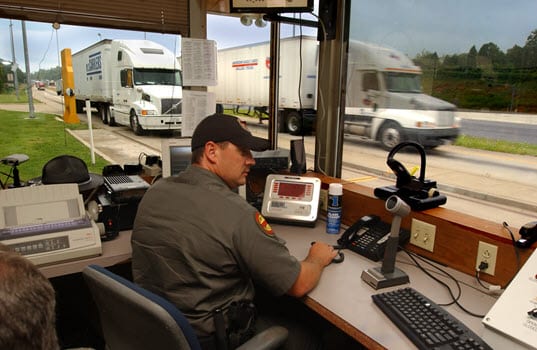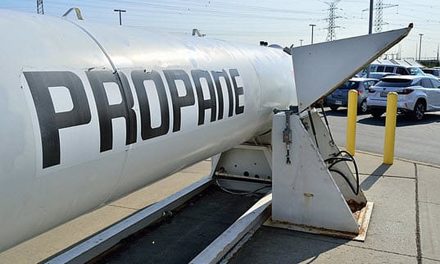By Brian Mofford
If you look at today’s big rig and compare it to a 2008 model, the technological advancements would boggle the mind. The safety options alone make today’s truck able to literally drive itself.
What about the rest of the industry—weigh stations and bypass in particular? Major advancements there as well. The weigh station your father may have seen is a far cry from today’s weigh station. Gone are the days when inspection officers trusted just their luck in choosing which vehicles need to go through a Level 3 inspection. Today, technology makes sure inspection officers are spending their time looking at the trucks that need to be inspected.
That’s because “smart” roadside weigh stations dot the United States and Canada, with more being added each month. These technology-filled stations feature a bevy of advancements, including vehicle waveform identification and advanced thermal imaging systems. Much of this technology was developed and patented by Drivewyze’s sister company, Intelligent Imaging Systems (IIS).
At the heart of many systems is IIS’ thermal inspection technology, which can heat-sense thermal signatures associated with unsafe and defective equipment such as inoperative brakes, failed bearings and under-inflated or damaged tires. Advanced image processing, coupled with decision-making algorithms within screening software, searches and flags possible defects for a more thorough inspection. It’s a huge time saver for law enforcement and lets inspectors focus more of their time on the trucks that truly need checking.
In addition, more states (often through their weigh station bypass partners) are adding weigh-in-motion sensors in the roadway. That data is transmitted too, allowing the system to compare current readings to historical weight data gathered at various other statewide locations. To ensure data from those weight readings are assigned to the right truck and trailer, an electronic screening platform can gather data via vehicle waveform identification (VWI). This uses magnetometers mounted on overhead signs to identify vehicles by measuring the truck and trailer’s magnetic “signature.” Each truck and trailer, even those spec’d identically, generate a unique magnetic footprint. While the signature changes over time, VWI can still recognize the readings and assign them to the corresponding trucks and trailers with a high degree of accuracy.
For general truck information, overhead (strobe) cameras can read license plates and DOT numbers day or night to help inspectors and officers identify the corresponding carrier information, such as vehicle registration and fuel tax records.
While technology assists law enforcement at weigh stations, technology is also helping safe fleets become more productive by becoming eligible to bypass these weigh stations altogether. Did you know that each time a truck pulls into a weigh station the average cost is about $9.30? It’s true. We ran data from more than 12 million customer site visits throughout the United States with Drivewyze’s PreClear Analytics tool and found the average pull-in to a weigh station lasts 3 minutes and 40 seconds and costs more than $9 in fuel, maintenance and operational costs. Now, multiply that by the number of trucks you run, and the number of weigh stations stops you make, and you can see how much time and money is lost. We’ve made this tool available (and free for all) to allow fleets thinking of subscribing to a bypass service to generate their own custom reports to see if a bypass service makes sense for them.
What exactly is bypassing? It started decades ago through short-range communication transponder technology. The truck had a transponder “badge” on the windshield, with the embedded information read by a transponder poll (reader) near the weigh station. But, over the past five years, weigh station bypass has evolved from the equivalent of a landline to a smartphone. Drivewyze, for example, uses a cloud-based software-as-a-service system that leverages cellular networks and the Internet to add transponder-like functionality to electronic logging devices (ELDs) and mobile devices such as tablets and mobile phones. It’s simple—no hardware—and it’s loaded and ready to use on many ELDs for fast activation.
The safer the fleet, the more likely bypasses occur. Everyone is also subject to a random factor requiring an occasional pull-in.
For those not familiar with how bypass works, here’s how. Under our system, it detects when you’re approaching a fixed weigh station or temporary inspection site that is Drivewyze enabled. Two miles out, thanks to geo-fencing, the service alerts the driver of the upcoming site, while at the same time transmitting the carrier’s information to the weigh station. In many states, with weigh-in-motion technology, that information is also transmitted once the truck runs over the sensors. At the weigh station, safety scores, registration and IFTA tax compliance is automatically examined and calculated against the bypass criteria established by each state. If the carrier and vehicle pass the criteria, at one mile out, the driver receives permission to bypass the site. The driver is signaled to pull-in if there’s an issue or if the random algorithm indicates it is time for a pull-in.
Cellular technology also benefits states. Weigh stations themselves don’t require the installation of expensive transponder poles and readers. This allows states, which want to offer bypass opportunities to fleets, to get up and running quickly, with no infrastructure cost.
There is no doubt that commercial vehicle pull-ins and inspections play a critical role in maintaining highway and road safety. It is a key enforcement process and safeguard to keep unsafe vehicles or drivers off the road. But, with nearly 5.7 million interstate-licensed commercial trucks on the road today and limited resources, inspection stations are often congested. Pre-clearing—bypassing—vehicles based on the state’s pre-determined safety criteria frees up inspection stations to focus on drivers, vehicles or fleets that may need their attention. With weigh station bypass, everyone wins.
 Brian Mofford is Vice President of Technology at Drivewyze and has more than 20 years of experience in Information Technology and Software Engineering. Brian led the development and launch of the Drivewyze™ PreClear weigh station bypass service, which was released commercially in August 2012.
Brian Mofford is Vice President of Technology at Drivewyze and has more than 20 years of experience in Information Technology and Software Engineering. Brian led the development and launch of the Drivewyze™ PreClear weigh station bypass service, which was released commercially in August 2012.









